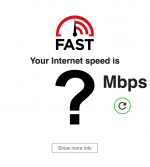The Mac Techs @ Sheridan
Mac Hardware: Internet Connectivity
General Information
Internet connectivity is increasingly important in the educational experience. Several factors influence the speed and reliability of your connection: hardware, Internet service provider, physical positioning of your wireless access point(s) (eg. wireless router), your device type(s), and more.
Testing Your Connection:

Visit this webpage: www.fast.comOnce your download speed has been measured...
Click “Show more info” to test your upload speed.
Understanding the Results:
You may experience problems with virtual classroom technologies (eg. Bongo via SLATE) if the results show:
⬇︎Download speed: below 50 Mbps
⬆︎Upload speed: below 5 MbpsNote: Your download and upload speed may be reduced if there is someone else on the same home network as you. For example, if someone is on a video chat on the same WiFi network, you may see your own Internet speed become slower at that time.
Knowing Your Options:
On an old Internet plan? Contact your current provider to see if there is a better plan offered at a similar price.
Thanks to the CRTC, major providers (Rogers, Bell, Cogeco) are not your only options. Many other providers can be found, and they often provide faster Internet plan options at cheaper rates.
Home Network Configuration
WiFi is impacted by a variety of factors, such as the capabilities (range / speed) of your wireless access point (eg. wireless router), the number of devices connected to the same network, the distance between the wireless access point and your device, and the types of Internet activity (eg. streaming 4K content). Generally speaking, the closer your device is to the wireless access point, the better your wifi connection will be. See our helpful links below for more information on best practices and troubleshooting.
Another common mode of connection to the Internet is by Ethernet cable. While most portable computers (notebooks) no longer have this port built-in, this can be resolved with a cost effective adapter. The choice of Ethernet adapter greatly depends on the specific computer that you have since this dictates the ports that are available for adapters to be connected. We're happy to help you figure this out, so don't hesitate to contact us.
Bandwidth versus Allowance
Internet plans generally have 3 numbers in their specification:
- Download Speed
How quickly your device(s) can receive content online
Examples: downloading files, watching video streams- Upload Speed
How quickly your device(s) can send content online
Examples: sharing your screen- Monthly Allowance
How much you can receive and send on a monthly basis
Note: Most non-cellular Internet plans are unlimited
Helpful Links
Fast.com: Internet Speed Testing
Wikipedia: Internet Service Providers in Canada
CRTC: Internet Services for Canadians
CRTC: Communication Service Providers in Canada
Government of Canada: Connecting Families
"for Canadian families who may struggle to afford access to home Internet"Apple Support: Recommended settings for Wi-Fi routers and access points
Microsoft Support: Fix Wi-Fi connection issues in Windows
Product: USB-C to Ethernet Adapter
Product: Thunderbolt to Ethernet Adapter
Support
If you are experiencing speed or configuration issues, we will try our best to help. Please contact us directly by emailing mactech@sheridancollege.ca